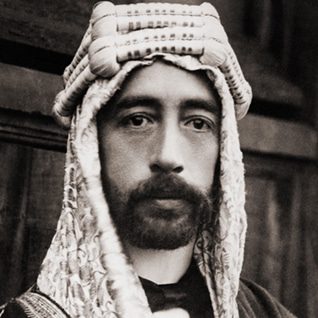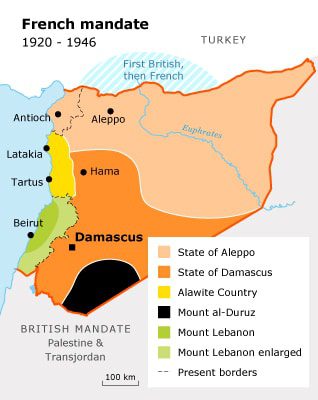
Introduction
Following the Ottoman Empire’s defeat in World War I, Syria was governed under a French mandate, despite pledges of independence made by the British and French during World War I, a betrayal that colors Syria’s relations with the West to this day.
Keen to secure Arab support against the Ottomans, the British offered their backing to a nationalist movement that was then stirring in the Ottoman Empire’s Arab territories. In 1915-1916 London negotiated with Sharif Husayn ibn Ali, the ruler of Mecca, Islam’s holiest city. In exchange for an Arab rebellion against the Turks, the British agreed to recognize the independence of the Arab territories of the Ottoman Empire, within certain limits. Britain also stipulated that Arab independence would apply only where that did not conflict with the interests of its wartime ally, France.
In June 1916 Sharif Husayn launched the Arab Revolt, with logistical support from the British (including T. E. Lawrence, ‘Lawrence of Arabia’). Having taken control of the Hijaz the rebels, commanded by Husayn’s third son, the emir (prince) Faysal, moved into Greater Syria, where they operated in cooperation with a British army that had invaded Palestine along the coast from Egypt. Faysal took Aqaba, at the head of the Red Sea, in July 1917, and Amman, then little more than a large village, in September. Jerusalem fell to the British three months later, and Damascus was taken in October 1918.
Sykes-Picot Agreement
While urging the Arabs to rebel, with promises of independence, London was quietly negotiating a conflicting deal with France and Russia. Concluded in May 1916, the so-called Sykes-Picot Agreement divided the region into French and British spheres of influence. The French were allocated a zone corresponding roughly to modern Lebanon, Syria, eastern Turkey, and northern Iraq, and the British were allocated an area corresponding to modern Israel, Palestine, Jordan, and southern Iraq. Jerusalem and part of Palestine were designated for some form of international administration, in recognition of their religious significance.
On 2 November 1917, meanwhile, following negotiations with the Zionist movement, London issued the Balfour Declaration, which affirmed that the British viewed ‘with favour the establishment in Palestine of a National Home for the Jewish people’.
In September 1918 supporters of the Arab Revolt declared an Arab government headed by Sharif Husayn’s son Faysal, even though Britain remained the real power in Syria.
The 1919 Paris Peace Conference agreed that the former possessions of the defeated Germans and Ottomans would be administered as mandates, under the supervision of a new international body, the League of Nations. It was resolved that France should have a mandate for Syria (including present-day Lebanon) and Britain should have Palestine (including present-day Jordan) and Iraq.
Prince Faysal
To pre-empt French designs, a General Syrian Congress of nationalist figures convened in Damascus in March 1920 and elected Faysal king of a united Syria, that is, the territory today encompassing Syria, Lebanon, Israel, Palestine, and Jordan. Twenty-nine Iraqis present proclaimed Faysal’s elder brother, Abdullah, king of an independent Iraq, but these were vain gestures. To formalize what had already been agreed in Paris, Britain, and France hastily convened a meeting, at San Remo, of the Supreme Council of the League of Nations.

On 5 May 1920 this granted France mandates over Syria and Lebanon and Britain mandates over Palestine and Iraq. Transjordan, the territory east of the Jordan River, was not explicitly mentioned, but, as it formed part of the Sykes-Picot Treaty’s zone of British influence, it was understood to form part of the Palestine mandate. French troops moved into Syria from Lebanon and occupied Damascus in July 1920. Faysal was forced into exile, although the British installed him as King of Iraq the following year.
Divide and Rule
France adopted a divide-and-rule policy in Syria, dividing the country into semi-autonomous statelets. In 1920 Greater Lebanon was formed by adding extensive, mainly Muslim, areas to the core area, Mount Lebanon, where Maronite Christians dominated and which, under the Ottomans, had been a separate administrative unit known as a mutasarrifiya. The same year the rest of Syria was divided into the states of Damascus, Aleppo, and of the Alawites (the latter was in north-western Syria, along the coast, a region inhabited largely by the heterodox Shiite Alawite sect). In 1921 a Jabal al-Druze State, centered on the southern Syrian heartland of the Druze, another heterodox Shiite sect, was added.

Under the Franco-Turkish Ankara Agreement of October 1921 the Sanjak (sub-province) of Alexandretta, with its mixed Turkish, Armenian, and Arab population, was that year added to Syria as an autonomous province. Against a background of insistent claims on the territory by Turkey, under the rule of Mustafa Kemal (later to be named Kemal Atatürk), Alexandretta was, in 1923, joined to Aleppo State while retaining a special administrative status.
In 1938 Turkish forces entered Alexandretta and expelled most of its Arab (mainly Alawite) and Armenian inhabitants. The same year, the province proclaimed independence as Hatay State, but in 1939 Hatay’s legislature voted for annexation to Turkey, as the province of Hatay, whose main port is Iskenderun, the former Alexandretta. In July of that year, the French departed from Syria.
In 1922-1924 the Alawite, Damascus, and Aleppo states were joined in a Syrian Federation. In January 1925 Damascus and Aleppo were united into a single Syrian state, while the Alawite State maintained its quasi-independence.


